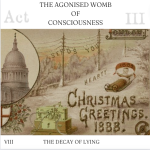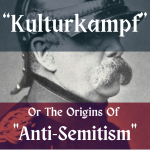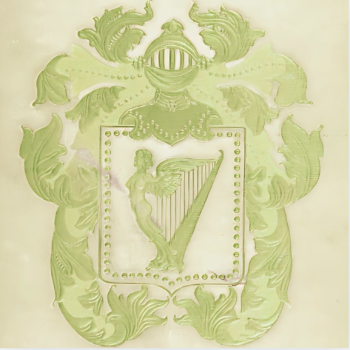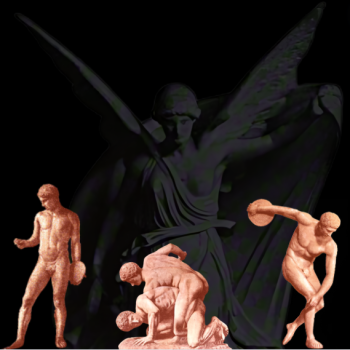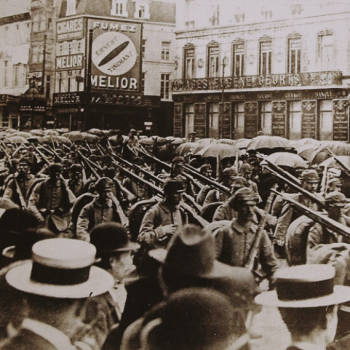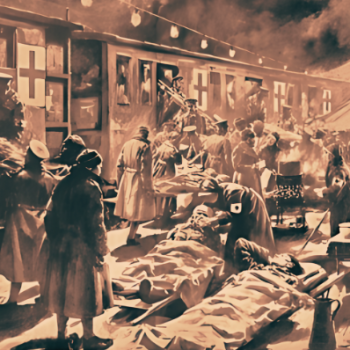A look at three Swedish-American immigrants who belonged to the Theosophical Society, and their influence on their adopted-home.
JAKOB BONGGREN
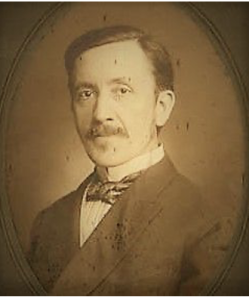
Jakob Bonggren.[1]
Jakob Bonggren (1854-1940,) was a postmaster from Mora, Sweden, who wrote occasional poetry and newspaper. He published a book of poetry that was critical of the inequality of Swedish society, and was offered a job in America working for the Chicago-based newspaper, Svenska Amerikanaren (The Swedish American.) Bonggren immigrate to the United States in 1882 with his wife, Johanna, and their three children, living briefly in Moline, Illinois. He moved to Chicago in 1883 where he joined the Theosophical Society in November of that year (as well as co-founding the first branch of the Society in that city.)[2] Bonggren writes:
Mr. Stanley B. Sexton came across Theosophy in 1879, I not sooner than 1883. The first branch here was founded November 27, 1884, the founders of it being Mr. Sexton, myself, Dr. and Mrs. Phelon. There were no office-hunters in the branch then, and I hope there will never be. At the first meeting I myself was offered the Vice-Presidency of the branch—an unusual honor for a foreigner here, in this proud America, where the motto is: “America for Americans,” but I declined the honor at once. Four members of the branch, all of them officers!—that seemed too comical to me altogether.[3]
Bonggren would become a leading figure in the Swedish-American community, and publish works such as Sånger Och Sagor: En Samling Dikter (Songs And Tales: A Collection Of Poems,) and The Second Coming of Christ.
MARIE OLSEN: “THE MOUNTAIN MAID.”
Marie Olsen (1864-1894) immigrated to America in 1884 when she was twenty years old. “Bright, quick-witted, vivacious and always self-possessed, she was entertaining in the extreme.” Through grit and determination, she settled a 160-acre plot of land in Roaring River, Missouri. Olsen’s “indomitable courage and energy had supported her in locating in a wild, mountainous section,” that inspired other settlers. This won her the love and respect of neighbors, as well as the nickname, the “Mountain Maid.”
In 1886 Olsen briefly moved to New York where her half-brother, Dr. Hjalmar Valentin Barclay, lived at 8 W. 116 Street. There she enrolled in the New York Training School for nurses. After graduating in 1888, she made a home for herself at 139 W. Thirteenth Street.[4] During the winter of 1892-1893, Olsen spent the winter in Chicago, Illinois, where she heard the Theosophical lecturer, Claude F. Wright.[5] On March 20, 1893, Olsen “forsook the Lutheran religion, in which she was reared,” and became a Theosophist.[6]
Almost a one year later, on March 13, 1894, Olsen died in her home at 139 W. Thirteenth Street. The news of her death stunned her friends and family, “surprise[ed] because no preceding intimation of a serious illness.” The following day a funeral service was heled in the home of Dr. Barclay. Claude Falls Wright officiated the funeral service. It was the third Theosophical cremation (in America,) and the first Theosophical Cremation Service for a woman (in America.)[7]
ANNA CRONHELM WALLBERG

Anna Cronhjelm Wallberg.[8]
Anna Cronhjelm Wallberg, the Scandinavian mythological lecturer credited with sparking popular interest in Scandinavian culture at the turn of the century. She received her early musical education at the Conservatory in her native city of Stockholm, Sweden. Becoming interested in physical culture, she enrolled herself as a pupil of Henrica Ling, the daughter of Pehr Henrik Ling (the inventor of the Swedish gymnastic system.) When she arrived in America, Wallberg devoted herself to lecturing in North America under the management of Major James Pond. (In 1890 her lectures on Henrik Ibsen proved quite popular.)[9]
In New York her talents were highly appreciated in literary circles, and spoke before Sorosis, the Woman’s Press Club, and prominent Swedish Societies of New York and Brooklyn.[10] In April 1893 she was present for the unveiling of the John Ericsson statue in New York, the occasion for which she read a dedicatory poem she composed.[11]
A month after the John Ericsson ceremony, Wallberg joined the Theosophical Society (May 30, 1893.)[12] As the “Wilson School Incident” was being fully ventilated in the press at the time, we might infer that her decision to join the Theosophists was compelled by a sense of solidarity. She did display an interest in children’s education, as she contributed an article “Swedish Children Their Home And School Life,” for the February 1893 issue of Childhood.[13] Records indicate that Wallberg was involved with the Lotus Circle, and helped organize their New Year’s pageant in 1894.[14]
Around the turn of the century, Wallberg moved to Boston, where she translated the works of Pelle Molin, Selma Lagerlöf, Hilma Angered Strandberg, and Karl Tavastjerna. In 1898 she would write the lyrics for the opera, “Fridthjof and Ingeborg.”[15]
SOURCES:
[1] Find a Grave, database and images (https://www.findagrave.com/memorial/198257198/jacob-bonggren: accessed 21 August 2023), memorial page for Jacob Bonggren (7 Oct 1854–24 Jul 1940), Find a Grave Memorial ID 198257198; Burial Details Unknown; Maintained by Good Oman (contributor 47813454).
[2] Theosophical Society General Membership Register, 1875-1942 at http://tsmembers.org/. See book 1, entry 3050. (Website file: 1B:1885-1890) Jakob Bonggren (11/10/1884); “Theosophical Activities.” The Path. Vol I., No. 1. (April 1886): 30-32.
[3] Bonggren, Jakob. “The Wisdom Religion.” The Inter Ocean. (Chicago, Illinois) April 12, 1889.
[4] “Miss M.W. Olsen.” The Cassville Republican. (Cassville, Missouri) January 28, 1892; Missouri State Gazetteer and Business Directory: Volume VIII. R.L. Polk & Company. Kansas City, Missouri. (1893): 1783; “’The Mountain Maid.’” The Cassville Republican. (Cassville, Missouri) March 29, 1894.
[5] “Announcements.” The Chicago Inter-Ocean. (Chicago, Illinois) March 19, 1893.
[6] Theosophical Society General Membership Register, 1875-1942 at http://tsmembers.org/. See book 1, entry 9348. (website file: 1C:1890-1894) Marie W. Olsen. (3/20/93); “Strange Rites.” The Cincinnati Post. (Cincinnati, Ohio) March 19, 1894.
[7] “Strange Rites.” The Cincinnati Post. (Cincinnati, Ohio) March 19, 1894; “’The Mountain Maid.’” The Cassville Republican. (Cassville, Missouri) March 29, 1894.
[8] “Front Cover.” Home Journal. Vol. LVIII, No. 5. (February 1, 1902): Front Cover.
[9] Manuscripts and Archives Division, The New York Public Library. “Wallberg, Anna Cronhjelm” New York Public Library Digital Collections. Accessed December 25, 2023. https://digitalcollections.nypl.org/items/332cca50-2bba-0136-881d-23b3da399fbc
[10] “Miss Anna C. Wallberg.” Home Journal. Vol. LVIII, No. 5. (February 1, 1902): 12.
ODE TO JOHN ERICSSON
By the one-eyed Odin, the Sun, who with lingering rays
Tore himself away
From the lovely and godlike Valkyria, who lay in a dreamless and happy sleep.
Thus the maiden guarded by a mighty fire
Lay in peaceful rest, unconscious of his ire,
Till the fearless hero of genius shielded himself ‘gainst
The fiery stream
And imprinted the kiss on the lips of the maiden and
that caused her to wake from her dream,
And inspired the heart of the hero with love, that found
Echo in her young heart, too.
Thus a hero springing from the miner’s race,
Of the Swedish mountains looked with wondering face,
As he lifted the helmet and shield from her beautiful
Curls and beautiful form saw
What he thought was the form of a man—a Valkyria fair
And approached her with awe,
And the rose and the woods and the stream were
Enraptured with joy at the beautiful sight.
Odin’s thorn of winter lost its dreadful spell
Love no longer was the free to act and tell
‘f her love for the hero, whose name she adored until
Death did unite them indeed.
And America honors today the great man whose
Invincible sword has freed
Her from slavery’s slumber—The world stands
Enraptured with joy at the beautiful sight.
When in time of danger and of sore distress,
Brother fought against brother—both with manliness—
The adopted son of America—descendants of Vikings
And Victors of yore
Came at once to the front, and with generous heart
Offered forth of his genius store,
And the world saw with wonder the flash from the
Cannon of Ericsson’s monitor.
Silently she moved down to Hampton Bay,
Like a monstrous giant, ah memorable day,
And such sight had been seen by immortal—the turret
That spread far and near dire woe
The enemy, scornfully marking the approach of the foe,
That restricted Merrimac’s course—by that victory
Changing America’s fate,
Him today we honor, North and South his name
Grateful lips are praising. White and black his fame
Shall on history’s page engrave, and to future
Generations his greatness proclaim
And in truth maty his country be proud of her son,
The world’s good being only his aim.
And be thankful that she could contribute her share
To humanity’s commonweal.
[“Ericsson’s Statue Unveiled.” The Brooklyn Citizen. (Brooklyn, New York) April 26, 1893.]
[12] Theosophical Society General Membership Register, 1875-1942 at http://tsmembers.org/. See book 1, entry 9655. (website file: 1D:1894-1897); Anna Cronhjelm Wallberg. (Aryan. 19 W. 34th Street, New York, New York. [5/30/1893.])
[13] W.R.O. “Reviews: Childhood.” The Theosophist. Vol. XIV, No. 8 (May 1893): 506-
[14] “Religions of All Nations.” The New York Times. (New York, New York) January 1, 1894.
[15] “Miss Anna C. Wallberg.” Home Journal. Vol. LVIII, No. 5. (February 1, 1902): 12.


